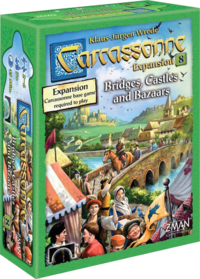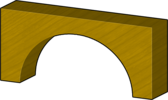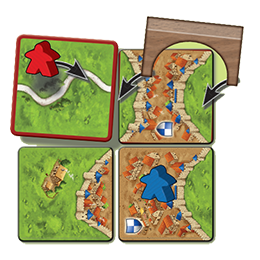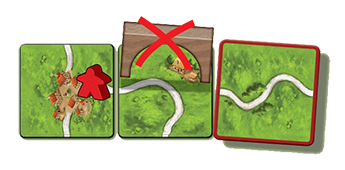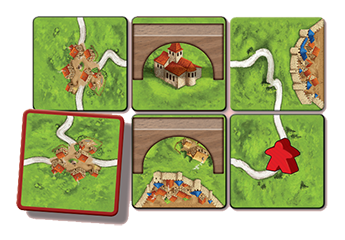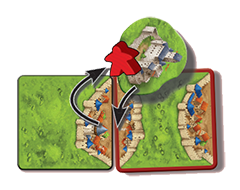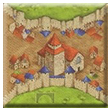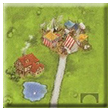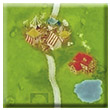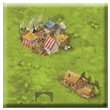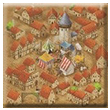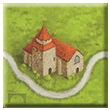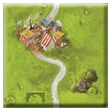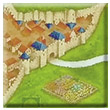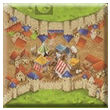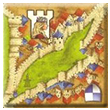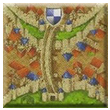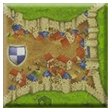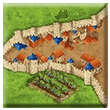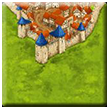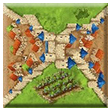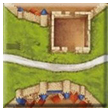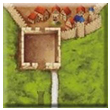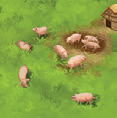Bridges, Castles and Bazaars
 |
You are reading the rules for this tile design. |
 | Read the following rules if your tiles look like this. |
| If your tiles have a different design, then choose a game from Spin-offs. |  |
Traveling traders arrive in the land and organize bazaars, in which haggling is considered an art. At the same time, engineers are expanding the road network with modern bridges, and small castles are being built everywhere to defend the region.
General info and comments
Bridges, Castles and Bazaars (originally Brücken, Burgen und Basare) was released for the New Edition by Hans im Glück in 2017. It is an update of the first edition released in 2010.
This is the eighth major expansion for Carcassonne and introduces some new aspects to the game.
This expansion includes 12 tiles that represent city segments, road segments and cloisters in new configurations plus the addition of bazaars which will help create much more than a beautiful landscape.
New features/elements are:
- Bridges, that allow players to add road segments to their tiles
- Castles, that score points for neighboring completed features
- Bazaars, that allow players to purchase tiles at an auction
Contents
- 12 new land tiles including 8 with a bazaar
- 12 castle tokens
- 12 wooden bridges
Rules
Preparation
Shuffle the new land tiles with those of the base game and stack them facedown as a general supply within easy reach of all players.
Then, depending on the number of players, give each player the corresponding number of bridges and castle tokens.
| Number of players | Bridges | Castle tokens |
|---|---|---|
| 2, 3, 4 players | ||
| 5, 6 players |
The twelve new land tiles should be mixed with those of the basic game. Over the course of play they will be drawn and placed according to the usual rules.
Bridges
1. Placing a tile
Just like in the base game, you must place tiles so that its edges match the edges of the tiles already in play. After placing a tile, you may [1] place one bridge, which counts as a road and connects roads over features or meeples on that tile. [2]
You can place a bridge on the tile you just placed, or on a tile touching the tile you just placed. When placing a bridge, you must place both ends in a field, and it must be placed facing either left-to-right or up-to-down (it cannot be placed diagonally across the tile). Once placed, a bridge remains on that tile until the end of the game.
You can place a tile so that a road ends against a field, but you must place a bridge that continues the road on that same turn. You can use multiple bridges in a row along the same road, but each tile can have a maximum of only one bridge on it. [3] Bridges can be placed on tiles with meeples on them.
2. Placing a meeple
After placing a tile, you can place a Meeple normally. If you build a bridge on the tile you just placed, you can place your meeple (or another figure) on the bridge as if it were a road.
3. Scoring a feature
Bridges are scored like tiles with a road on them. [4]
Bridges do not separate cities or fields.
Castles
3. Close a small city and place a castle [5]
When you place a tile that completes a small city (a city consisting of only 2 semi-circular segments [6] [7]), the owner of the small city chooses to either score 4 points as normal, or to place a castle on that small city instead.
When the owner places a castle, cover the small city that was just completed with a castle from your supply, and place the meeple that was in the small city on top of the castle. [8] [9]
Once placed, a castle remains on that small city until the end of the game.
A castle with a meeple is not yet completed. [10] [11]
When placing a castle, it does not matter whether your meeple is already on the first half of the small city before the castle is placed, or whether you place the meeple on the second half of the small city you just completed. [10]
3. Scoring a castle
Placing a castle does not score you any points. Instead, you score points when a neighboring feature is completed in a later turn. [12] [13] [14] A feature is considered neigboring if it is on either one of the 2 tiles containing your castle, the 2 tiles to the right, or the 2 tiles to the left - a total of 6 tiles.
Only part of the completed feature needs to be on a neighboring tile for you to score points for it. Both you and the player who would normally score points for that feature score its full points. [15] Once you score points for a neighboring feature, your meeple is returned to your supply, but your castle remains on its place until the end of the game.
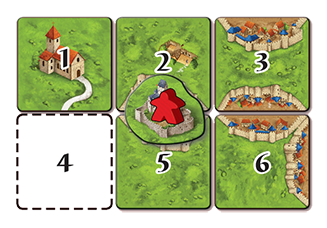
- The monastery on 1
- The road to 1
- The top city on 3
- The right city on 6
The following rules apply to castles:
- You must score points for the first feature completed on a tile neighboring your castle. You cannot forego scoring to leave your meeple for a later feature.
- Even if the first completed feature does not contain a meeple, you still score points from it if it is neighboring your castle. [16]
- If you control both a castle and the next completed neighboring feature, you score its points twice (once for the feature and once for the castle).
- A monastery is only neighboring a castle if the tile with the monastery on it is in one of the 6 neighboring spaces.
- If a tile is placed that causes multiple features that are neighboring your castle to be completed at the same time, you [17] decide which of them to receive points for. [18] A castle can only get points from one single feature. [19]
- Two or more incomplete castles may be standing next to each other. If one of them scores points, it will be considered as a completed feature for the adjacent castles. All the castle owners receive the same number of points. [20] [21] [22]
- Castles separate fields, just like roads or cities.
Final Scoring
At the end of the game, remove all the meeples still standing in a castle in the playing area before the final scoring. Nobody gets more points for them. [23]
When determining the value of a field, castles are worth 4 points (instead of 3).
Bazaar
When you draw a tile with a bazaar on it, do the steps: 1. Place a tile, 2. Place a meeple and 3. Score a feature normally. [24] You cannot place a meeple on the bazaar.
4. Host a bazaar auction
After you have placed a bazaar and completed your turn, a bazaar auction of landscape tiles takes place. Skip this step if there are fewer tiles remaining than there are players.
Draw and reveal a number of tiles equal to the number of players. The player on your left (the first auctioneer) then chooses one of those tiles and bids a number of points for it (the bid can also be 0 points [25]). Continuing clockwise, players take turns bidding either a greater number of points or passing, until all players have had the chance to bid or pass. Then, the player who chose the tile must either:
- Buy the tile from the highest bidder, by giving that player a number of points equal to the highest bid, OR
- Sell the tile to the highest bidder, by taking from that player a number of points equal to the highest bid.
The score track is then adjusted so the buyer loses a number of points equal to the high bid, while the seller gains an equal number of points. The buyer then takes the tile that was being auctioned. If the only player to place a bid was the player who chose the tile, he or she pays a number of points equal to their bid, but no other player gains those points.
It is possible to bid more points than you have, and players can have a negative score as a result of buying tiles, especially at the beginning of the game.
Once a player has taken a tile during a bazaar auction, he or she is out of the round and cannot bid any more. Among the players who have not yet taken a tile this round, the next player clockwise from the previous auctioneer [26] chooses (as the new auctioneer) which tile will be auctioned next, and a new auction begins. This continues until only one tile remains, and the player still without a tile takes it for free.
Now all players have one purchased tile. Starting in clockwise order with the player on the left of the active player, [27] [28] all players play their purchased tile as in a normal turn with phases 1. Placing a tile, 2. Placing a meeple (if he or she wishes), and 3. Scoring a feature. Of course, nobody draws a tile in this "bazaar" round. [29]
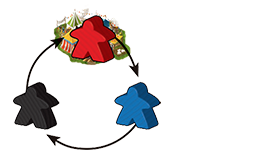
You draw a bazaar tile and place it normally. After your turn is complete, you draw 3 tiles for the auction.
- Blue chooses one of the tiles and bids 2 points. Black passes, and you bid 3 points. Because you are the highest bidder, and blue still wants the tile, he or she buys it from you by losing 3 points, while you gain 3 points.
- Black chooses the next tile, and bids 2 points. You bid 3 points, and Black decides to sell you the tile. You lose 3 points and Black gains 3 points.
- There is only one tile left, which Black takes for free. Starting with Blue, each player places his or her tile normally.
Once the bazaar round is complete, play resumes normally starting with the player to your left.
No chain reaction: If a bazaar tile auctions another bazaar tile, no auction takes place when the second bazaar tile is placed. Only after all auctioned tiles have been placed, a new bazaar auction can take place. [30]
Bazaar Variant Rule: When you place a bazaar tile, draw and reveal a number of tiles equal to the number of players. Beginning with the player to your left, each player takes and immediately plays one of the tiles from the ones you revealed as in a normal turn. Then play resumes normally starting with the player to your left. [31]
Clarifications for new landscape tiles
The expansions includes some tiles with special characteristics.
Other expansions
This section contains additional information about the interactions with other Carcassonne expansions.
![]() You can place the following figures on a bridge:
You can place the following figures on a bridge:
- Normal meeple, the standard option (Base game)
- Large meeple (Exp. 1 - Inns and Cathedrals)
- Builder (Exp. 2 - Traders and Builders)
- Wagon (Exp. 5 - Abbey & Mayor)
- Ringmaster (Exp. 10 - Under the Big Top)
- Guard meeple (Exp. 11 - Ghosts, Castles and Cemeteries)
- Phantom (The Phantom)
![]() Scoring modifiers, scoring bonuses and actions affecting a road network will also affect a bridge connected to it:
Scoring modifiers, scoring bonuses and actions affecting a road network will also affect a bridge connected to it:
- Inns (Exp. 1 - Inns & Cathedrals)
- Mage (Mini #5 - Mage and Witch)
- Witch (Mini #5 - Mage and Witch)
- Solovei Razboynik actions (Russian Promos)
- German castles (Castles in Germany)
- German cathedrals (Cathedrals in Germany)
- Bathhouses (The Barber-Surgeons)
- Labyrinth bonus (The Labyrinth)
- Wainwrights quarter bonus (The Markets of Leipzig)
![]() Scoring bonuses and actions affecting a tile will also affect a bridge placed on that tile:
Scoring bonuses and actions affecting a tile will also affect a bridge placed on that tile:
- Dragon eating figures (Exp. 3 - The Princess and the Dragon)
- Fairy protection (Exp. 3 - The Princess and the Dragon)
- Watchtower bonus (The Watchtowers): meeples on bridges may trigger the bonus and have to be considered for the watchtower scoring for meeples.
- Gold pieces (Mini #4 - The Goldmines)
- Little buildings (Little Buildings)
- Vodyanoy action (Russian Promos)
![]() Scoring bonuses and actions affecting locally printed roads on a tile by proximity (the feature must be on the road) or connectivity (the feature must be connected to the road) will not affect bridges passing over the tile automatically:
Scoring bonuses and actions affecting locally printed roads on a tile by proximity (the feature must be on the road) or connectivity (the feature must be connected to the road) will not affect bridges passing over the tile automatically:
- Inns (Exp. 1 - Inns & Cathedrals)
- German castles (Castles in Germany)
- Bathhouses (The Barber-Surgeons)
- Features considered by tollhouses (The Tollkeepers)
- Solovei Razboynik action (Russian Promos)
![]() Inns on a tile will not affect a bridge placed on the tile. The inn only affects the printed road segment(s) next to it. However, the bridge will profit from an inn, the same as any other printed road segment, if they are part of the same road network.
Inns on a tile will not affect a bridge placed on the tile. The inn only affects the printed road segment(s) next to it. However, the bridge will profit from an inn, the same as any other printed road segment, if they are part of the same road network.
![]() Question: Inns affect those road segments they are on, that is, directly adjacent to. So a bridge placed on a tile with an inn would not be affected by it, since the inn would not be accessible from the bridge. Is this correct? See tile examples from Exp. 8 below.
Question: Inns affect those road segments they are on, that is, directly adjacent to. So a bridge placed on a tile with an inn would not be affected by it, since the inn would not be accessible from the bridge. Is this correct? See tile examples from Exp. 8 below.
![]() You can place a bridge and a tower on the same tile. If necessary, adjust the tower's position to make room for the bridge.
You can place a bridge and a tower on the same tile. If necessary, adjust the tower's position to make room for the bridge.
![]() You can place a bridge over the campground (with or without the big top) on a circus tile.
You can place a bridge over the campground (with or without the big top) on a circus tile.
![]() You cannot place an acrobat on an acrobat tile with a bridge on it.
You cannot place an acrobat on an acrobat tile with a bridge on it.
![]() A little building on a tile will affect a bridge placed on that tile.
A little building on a tile will affect a bridge placed on that tile.
![]() A watchtower scoring for neighboring tiles with road segments will also consider tiles with a bridge.
A watchtower scoring for neighboring tiles with road segments will also consider tiles with a bridge.
![]() You can place the following figures in a castle:
You can place the following figures in a castle:
- Normal meeple, the standard option (Base game)
- Large meeple (Exp. 1 - Inns and Cathedrals)
- Wagon (Exp. 5 - Abbey & Mayor)
- Mayor, however, since the castle doesn't have a coat of arms, the mayor cannot score points (Exp. 5 - Abbey & Mayor)
- Ringmaster (Exp. 10 - Under the Big Top)
- Guard meeple (Exp. 11 - Ghosts, Castles and Cemeteries)
- Phantom (The Phantom)
![]() Castle scoring may be triggered by the completion of any of following features (even if unoccupied):
Castle scoring may be triggered by the completion of any of following features (even if unoccupied):
- Road (Base game): at least one of the road tiles overlaps the castle fief.
- City (Base game): at least one of the city tiles overlaps the castle fief.
- Monastic building: the feature tile overlaps the castle fief
- Monastery (Base game)
- Abbey (Exp. 5 - Abbey & Mayor)
- Shrine (Exp. 6 - Count, King and Robber)
- German monastery (Monasteries in Germany)
- Dutch & Belgian monastery (Monasteries in the Netherlands & Belgium)
- Japanese building (Japanese Buildings)
- Darmstadt church (Darmstadt Promo)
- Castle: at least one of the other completed castle tiles overlaps the castle fief
- Garden (Base game - The Abbot): the garden tile overlaps the castle fief
- Baba Yaga's hut (Russian Promos): the feature tile overlaps the castle fief
- German castle (Castles in Germany): the castle tile overlaps the castle fief
- German cathedral (Cathedrals in Germany): the cathedral tile overlaps the castle fief
![]() When scoring a castle, you still score bonus points for these features (see full detail below including other feaures):
When scoring a castle, you still score bonus points for these features (see full detail below including other feaures):
- Roads with an inn (Exp. 1 - Inns and Cathedrals)
- Cities with a cathedral (Exp. 1 - Inns and Cathedrals)
- Monasteries or shrines with a vineyard (Exp. 9 - Hills & Sheep)
![]() Features triggering a castle scoring
Features triggering a castle scoring
The following table details the feature scoring modifiers and bonuses applicable to a feature when scored. The resulting points will be scored by the owner of the castle unless the castle lord is a mayor:
Legend:
| Value | Yes | N/A |
|---|---|---|
| Symbol |
| Features triggering a castle scoring | ||||||||
|---|---|---|---|---|---|---|---|---|
| Scoring Modifiers | Road | City | Monastic building (1) | Another castle | Garden | Baba Yaga’s Hut | German Castle | German Cathedral |
| Inn | ||||||||
| Cathedral | ||||||||
| Vineyard | ||||||||
| Mage / Witch | ||||||||
| Labyrinth | ||||||||
| German Castle | ||||||||
| Bathhouse | ||||||||
| Besiegers / Cathars / Siege | ||||||||
| Little Buildings | ||||||||
| German Cathedral | ||||||||
| Darmstadtium | ||||||||
| Scoring Tiles | ||||||||
Notes:
- Monastic building represents any of the following features: monastery, abbey, shrine, German monastery, Dutch & Belgian monastery, Japanese building, Darmstadt church.
![]() Special case: small cities and castles with multiple meeples
Special case: small cities and castles with multiple meeples
![]() Small cities are normally occupied by one single meeple from one player. However, several meeples (from one or more players) may occupy the same small city if playing with Mini #1 - The Flier (Flying Machines). In this case, if only one player has the majority in the feature, that player will be the one either scoring it or converting the small city into a castle only occupied by the meeple(s) of the player with the majority.
Small cities are normally occupied by one single meeple from one player. However, several meeples (from one or more players) may occupy the same small city if playing with Mini #1 - The Flier (Flying Machines). In this case, if only one player has the majority in the feature, that player will be the one either scoring it or converting the small city into a castle only occupied by the meeple(s) of the player with the majority.
Additionally, some special situations may arise when meeples from different players share the majority in the same small city, since each player may decide differently. So, we may encounter the following scenarios:
- All the players with the majority decide to score the small city: The city will be scored as usual taking into account the majority in the feature.
- All the players with the majority decide to convert the small city into a castle: The resulting castle will have several occupiers (the meeples from the players sharing the majority in the small city). If the castle is completed eventually, all the players sharing the castle will score points for it.
- Some of the players sharing the majority decide to score the small city and the rest choose to convert it into a castle: The players scoring the city will apply the majority without taking into consideration those meeples from players who decided to convert the small city into a castle. After scoring, the meeples involved will be returned to their owners. The castle will be created only with the meeples of the players who decided to convert the small city. If the castle is completed eventually, all the players sharing the castle will score points for it.
Additional notes:
- Deploying meeples from the city of Carcassonne: If playing with the Count of Carcassonne (Exp. 6 - Count, King & Robber), players will be allowed to deploy meeples from the city of Carcassonne to the small city only if at least one player is scoring it. All these additional meeples will participate in the scoring only. They cannot be deployed to the small city to later occupy the resulting castle if any player decided to convert it instead of scoring the small city.
- Castle tokens: Each player who chose to convert the small city into a castle will have to place a castle token from their supply on top of the small city. No player can keep their castle token for a later use because other player was placing theirs. As an alternative, instead of stacking the castle tokens, you may place only one of them and remove the rest from the game.
This means that a player without any castle tokens in their supply cannot decide to convert a shared small city into a castle. In this case, the player can only score the small city.
![]() When scoring fields with a pig, the castle is worth 5 points.
When scoring fields with a pig, the castle is worth 5 points.
![]() Exp. 3 - The Princess & the Dragon
Exp. 3 - The Princess & the Dragon
![]() The dragon cannot eat meeples in the castle.
The dragon cannot eat meeples in the castle.
![]() You can place the fairy with a meeple in the castle and score the usual fairy points. [33]
You can place the fairy with a meeple in the castle and score the usual fairy points. [33]
![]() The fairy, if assigned to a meeple in a castle at the end of the game, will not grant its bonus, since all remaining castle lords are removed before the final scoring takes place.
The fairy, if assigned to a meeple in a castle at the end of the game, will not grant its bonus, since all remaining castle lords are removed before the final scoring takes place.
![]() A tower cannot capture any meeples in the castle.
A tower cannot capture any meeples in the castle.
![]() When scoring a field, whether for farmers or barns, a castle is worth 1 point more than a completed city.
When scoring a field, whether for farmers or barns, a castle is worth 1 point more than a completed city.
![]() A wagon placed in castle can move to valid feature in the castle fief after scoring.
A wagon placed in castle can move to valid feature in the castle fief after scoring.
![]() Question: Can a wagon placed in a castle move to a neighboring unoccupied feature after scoring?
Question: Can a wagon placed in a castle move to a neighboring unoccupied feature after scoring?
Answer: Yes, the wagon can move to a neighboring unoccupied feature after scoring. (2/2021)
![]() When scoring a circus, your meeple in the castle scores points if part of the castle lies within the circus' surroundings.
When scoring a circus, your meeple in the castle scores points if part of the castle lies within the circus' surroundings.
![]() For the purpose of scoring the castle, acrobat pyramids do not count as completed features.
For the purpose of scoring the castle, acrobat pyramids do not count as completed features.
![]() At the end of the game, the last circus scoring should be carried out before removing any remaining castle lord from the playing area.
At the end of the game, the last circus scoring should be carried out before removing any remaining castle lord from the playing area.
![]() Castles do count for scoring of the Famine sector of the Wheel of Fortune, as this is effectively a scoring of farms.
Castles do count for scoring of the Famine sector of the Wheel of Fortune, as this is effectively a scoring of farms.
![]() The Mage and the Witch cannot be placed on a castle, since it is not a city anymore. This implies that any of these figures placed on a small city should be removed when converting it to a castle.
The Mage and the Witch cannot be placed on a castle, since it is not a city anymore. This implies that any of these figures placed on a small city should be removed when converting it to a castle.
![]() Monasteries in Germany /
Monasteries in Germany / ![]() Monasteries in the Netherlands & Belgium /
Monasteries in the Netherlands & Belgium / ![]() Japanese Buildings
Japanese Buildings
![]() Because an abbot scores only at the end of the game, and this monastery is never considered completed, a monastery with an abbot will not score points for a meeple in a castle. (5/2014)
Because an abbot scores only at the end of the game, and this monastery is never considered completed, a monastery with an abbot will not score points for a meeple in a castle. (5/2014)
![]() These special monasteries can only be completed if unoccupied or if occupied by at least one monk (no matter if other meeples are placed as abbots on the same feature). A special monastery will not be considered completed when surrounded by tiles if only occupied by meeples placed as abbots.
These special monasteries can only be completed if unoccupied or if occupied by at least one monk (no matter if other meeples are placed as abbots on the same feature). A special monastery will not be considered completed when surrounded by tiles if only occupied by meeples placed as abbots.
![]() The Besiegers /
The Besiegers / ![]() The Cathars /
The Cathars / ![]() Siege
Siege
![]() A city under siege (or under attack from Cathars) can be converted to a castle, and it is handled as a normal castle. The siege or Cathar attack is ignored after conversion to a castle.
A city under siege (or under attack from Cathars) can be converted to a castle, and it is handled as a normal castle. The siege or Cathar attack is ignored after conversion to a castle.
![]() Meeples in castles are safe from the plague, as it affects the tile directly, and castles are not present on a specific tile.
Meeples in castles are safe from the plague, as it affects the tile directly, and castles are not present on a specific tile.
![]() If you place a bazaar tile and it expands [35] [36] a road or city containing your builder, complete the bazaar round before beginning your double turn. [37]
If you place a bazaar tile and it expands [35] [36] a road or city containing your builder, complete the bazaar round before beginning your double turn. [37]
![]() During a bazaar round, if another bazaar tile is placed in a builder-turn, the bazaar will be ignored. (2/2021)
During a bazaar round, if another bazaar tile is placed in a builder-turn, the bazaar will be ignored. (2/2021)
![]() Question: What is the order of events if the bazaar tile extends a feature with a builder?
Question: What is the order of events if the bazaar tile extends a feature with a builder?
If you draw a bazaar tile and can perform your builder-turn, first take the appropriate number of face-down tiles and perform the bazaar and the auction. Then a new round with a special property starts – each player has an open and known tile instead of drawing an unknown tile, and you cannot place your abbey as your first tile. If you placed your auctioned tile and you can perform a builder-turn, you can choose to place your abbey or draw a new unknown tile. If any player draws a new bazaar tile [for their builder-turn or for message 4], it will be ignored until the last player who has an auctioned tile finishes his turn (including his builder-turn, if possible). Therefore, any ignored bazaars will not take place. Once the bazaar round is finished, you perform your builder-turn.
In other words:
- Draw bazaar and perform first part of your double turn.
- Draw the tiles (still face-down)
- Turn tiles face-up and perform the auction
- ( Start ignoring any new bazaars )
- 1st Player with auctioned tile (if a bazaar tile, no bazaar is triggered)
- 1st player’s builder-turn, if applicable (if a bazaar tile, no bazaar is triggered)
- Next player with auctioned tile (if a bazaar tile, no bazaar is triggered)
- Next player’s builder-turn, if applicable (if a bazaar tile, no bazaar is triggered)
- ...
- Last player with auctioned tile (if a bazaar tile, no bazaar is triggered)
- Last player’s builder-turn, if applicable (if a bazaar tile, no bazaar is triggered)
- ( Stop ignoring any new bazaars )
- Perform your builder-turn (second part of your double turn)
![]() Exp. 3 - The Princess & the Dragon
Exp. 3 - The Princess & the Dragon
![]() If you place a dragon tile during a bazaar round, the dragon moves. After that, the bazaar round continues.
If you place a dragon tile during a bazaar round, the dragon moves. After that, the bazaar round continues.
Tile distribution
Note: The initial tile distribution by HiG in Germany and by Mindok in Czech Republic and Slovakia (not in Poland) presented the following differences by mistake: Tiles marked with (–) were missing and, instead, two copies of the tiles marked with (+) were included.
Moreover, two tiles present an additional feature indicated in bold, an inn, that serves as a tie-in with Exp. 1 - Inns and Cathedrals.
Footnotes
For Icons explanation and licensing please visit Icons page.
- ↑
 Note the use of the word "may" in the statement. A player is not required to use a bridge to place a tile, even if that tile would otherwise have to be discarded. The player has the choice to use the bridge to place the tile or just discard the tile. (10/2014)
Note the use of the word "may" in the statement. A player is not required to use a bridge to place a tile, even if that tile would otherwise have to be discarded. The player has the choice to use the bridge to place the tile or just discard the tile. (10/2014)
- ↑
 As with normal roads, each end of the bridge must continue a road segment (or bridge) already in play or must be adjacent to an empty place for a tile. (12/2014)
As with normal roads, each end of the bridge must continue a road segment (or bridge) already in play or must be adjacent to an empty place for a tile. (12/2014)
- ↑
 One tile cannot have 2 bridges running perpendicular to each other. The rules state that the bridge must lie on a field, and if bridges are stacked, one end of the top bridge will not touch the field.
One tile cannot have 2 bridges running perpendicular to each other. The rules state that the bridge must lie on a field, and if bridges are stacked, one end of the top bridge will not touch the field.
- ↑
 As the bridge is counted just like a printed road segment, any completed road that includes a bridge and a printed road segment on the same tile still only scores 1 point for the tile. (2/2014)
As the bridge is counted just like a printed road segment, any completed road that includes a bridge and a printed road segment on the same tile still only scores 1 point for the tile. (2/2014)
- ↑
 This section has been reworded to include all details left out by ZMG:
This section has been reworded to include all details left out by ZMG:
- A small city can only consist of two semicircular tiles
- The owner of the city decides whether to score the small city or convert it into a castle
- The meeple on the completed city is moved into the castle
- A castle with a meeple is considered incomplete
- It does not matter which half of the city has its owner's meeple
- ↑
 The HiG rules state that a small city consisting of "two semi-circular city segments" would qualify for castle placement, which would not allow you to use, for example, a triangular city segment. The castle token has to cover the small city completely in order to replace it visually on the board. (7/2010)
The HiG rules state that a small city consisting of "two semi-circular city segments" would qualify for castle placement, which would not allow you to use, for example, a triangular city segment. The castle token has to cover the small city completely in order to replace it visually on the board. (7/2010)
This point was confirmed by Christof Tisch (HiG) on BGG:
https://boardgamegeek.com/thread/538079/1-question-about-castles
 This means the following tiles cannot be part of a small city converted into a castle, since the castle token would reveal some city "ruins" from the small city underneath: parts of city walls, city bridges, or even partial city segments:
This means the following tiles cannot be part of a small city converted into a castle, since the castle token would reveal some city "ruins" from the small city underneath: parts of city walls, city bridges, or even partial city segments:
The base game of the third edition includes semi-circular city segments that reach the middle of the tile. They should be valid to build a castle even if they do not strictly comply with the aforementioned clarification. This should also apply to other instances of larger semi-circular cities:
- ↑
 The ZMG rules define small city as "a city consisting of only 2 tiles." This lack of constraints would allow small cities to combine tiles different than regular semi-circular segments, such as witch-hat city segment. The only hint otherwise is provided by the examples.
The ZMG rules define small city as "a city consisting of only 2 tiles." This lack of constraints would allow small cities to combine tiles different than regular semi-circular segments, such as witch-hat city segment. The only hint otherwise is provided by the examples.
- ↑
 When placing a castle on these tiles from The Tower, you may need to move a tower on them a bit aside.
When placing a castle on these tiles from The Tower, you may need to move a tower on them a bit aside.
- ↑
 The ZMG rules ommit the placement of the meeple on the castle.
The ZMG rules ommit the placement of the meeple on the castle.
- ↑ 10.0 10.1
 The ZMG rules ommit this sentence.
The ZMG rules ommit this sentence.
- ↑
 The castle is considered incomplete at this point.
The castle is considered incomplete at this point.
- ↑
 The HiG rules specify that castles score when features are completed in their fief in a subsequent turn: "You won't get any points when you build the castle. You get points for your castle if the first feature (monastery, city or road) in the vicinity of your castle is completed in a later turn." This detail is not mentioned explicitly in the ZMG rules.
The HiG rules specify that castles score when features are completed in their fief in a subsequent turn: "You won't get any points when you build the castle. You get points for your castle if the first feature (monastery, city or road) in the vicinity of your castle is completed in a later turn." This detail is not mentioned explicitly in the ZMG rules.
- ↑
 This reference to "a later turn" should be interpreted as a later round of scoring, that is, you cannot create a castle and score it right away. So at least one tile placement has to happen before the castle can be scored. With this in mind, during a double turn (technically one turn with two parts), you would be able to create a castle in the first part of your turn and score it as soon as the second part of the same turn. There is no provision in the rules for ignoring completed features after the castle is created, only during the same round of scoring the castle is created. Check the following example:
This reference to "a later turn" should be interpreted as a later round of scoring, that is, you cannot create a castle and score it right away. So at least one tile placement has to happen before the castle can be scored. With this in mind, during a double turn (technically one turn with two parts), you would be able to create a castle in the first part of your turn and score it as soon as the second part of the same turn. There is no provision in the rules for ignoring completed features after the castle is created, only during the same round of scoring the castle is created. Check the following example:
- You place a tile that extends a city with your builder and completes a small city that you turn into a castle (claimed by you, of course). The builder grants you a double turn.
- During the second part of your double turn, you complete another feature in the castle fief and you score the feature and the castle created in the first part of the turn.
- You place a tile that completes a small city occupied by you and another feature occupied by you. You turn the small city into a castle and score the other feature. After scoring your scoring meeple lands on a dark space and you receive Message 4.
- You draw a new tile that completes another feature in the fief of the castle just created on this turn. The Message is dispatched on the very same turn but it creates a new round of scoring. As a result, you score the completed feature and the castle.
- ↑
 The castle is considered completed at this point.
The castle is considered completed at this point.
- ↑
 This is after any bonuses or penalties (such as the Cathedral or Witch) are accounted for. (4/2014)
This is after any bonuses or penalties (such as the Cathedral or Witch) are accounted for. (4/2014)
- ↑
 Note that this statement essentially indicates that points are tallied for all completed features, even unoccupied ones. However, generally nobody scores (receives those points) for an unoccupied feature. (2/2015)
Note that this statement essentially indicates that points are tallied for all completed features, even unoccupied ones. However, generally nobody scores (receives those points) for an unoccupied feature. (2/2015)
- ↑
 As seen in the 1st edition rules, "you" means "the owner of the castle", not the active player (i.e. the player placing the tile which triggers the castle scoring).
As seen in the 1st edition rules, "you" means "the owner of the castle", not the active player (i.e. the player placing the tile which triggers the castle scoring).
- ↑
 In practical terms, this would probably mean the same as choosing the completed feature worth the most points.
In practical terms, this would probably mean the same as choosing the completed feature worth the most points.
- ↑
 ZMG rules modified the meaning of this paragraph, stating that:
ZMG rules modified the meaning of this paragraph, stating that:
- "If a tile is placed that causes multiple features that are neighboring your castle to be completed at the same time, you decide what order they are scored. As always, you only score points for the first feature."
- ↑
 A completed castle overlapping another castle's fief will trigger the scoring of the latter. If two castles overlap each other's fiefs, the completion of any of those castles will trigger their scoring reciprocally, so they will be scored together. Of course, this triggering may affect more than two castles.
A completed castle overlapping another castle's fief will trigger the scoring of the latter. If two castles overlap each other's fiefs, the completion of any of those castles will trigger their scoring reciprocally, so they will be scored together. Of course, this triggering may affect more than two castles.
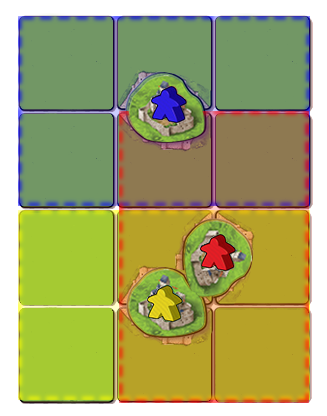 Example: The yellow castle and the red castle overlap each other's fief. The blue castle overlaps the red castle fief but not vice versa. The blue and the yellow castle fiefs don't overlap.
Example: The yellow castle and the red castle overlap each other's fief. The blue castle overlaps the red castle fief but not vice versa. The blue and the yellow castle fiefs don't overlap.- A completed feature triggering the scoring the red castle or the yellow castle will be scored by both castles. The blue castle, when completed, can trigger the scoring of both castles, since the blue castle overlaps the red castle fief.
- However, the completion of the red castle (and therefore the yellow castle) will not trigger the scoring of the blue castle, since the red castle does not overlap the blue castle fief.
- ↑
 In case of conflict when deciding the value of adjacent castles scoring the same points, the active player should decide.
In case of conflict when deciding the value of adjacent castles scoring the same points, the active player should decide.
- ↑
 This paragraph has been reworded according to the German rules. The English wording by ZMG is less clear: "If a castle is scored while neighboring your castle, your castle is also scored. All castles involved in such a scoring score points from the initial completed neighboring feature."
This paragraph has been reworded according to the German rules. The English wording by ZMG is less clear: "If a castle is scored while neighboring your castle, your castle is also scored. All castles involved in such a scoring score points from the initial completed neighboring feature."
- ↑
 The ZMG rules ommitted the removal of the meeples in unscored castles.
The ZMG rules ommitted the removal of the meeples in unscored castles.
- ↑
 If the tile cannot be placed and is discarded, the bazaar will not occur. (10/2014)
If the tile cannot be placed and is discarded, the bazaar will not occur. (10/2014)
- ↑
 Clarification included in the German rules but omitted by ZMG.
Clarification included in the German rules but omitted by ZMG.
- ↑
 The ZMG edition states that "the next player clockwise from the previous buyer," but the German rules state "the next player in a clockwise direction who has not yet received a tile" referring to the next player clockwise to the one who chose the previous tile to be auctioned. We included the reference to the "auctioneer" to clarify the sequence.
The ZMG edition states that "the next player clockwise from the previous buyer," but the German rules state "the next player in a clockwise direction who has not yet received a tile" referring to the next player clockwise to the one who chose the previous tile to be auctioned. We included the reference to the "auctioneer" to clarify the sequence.
- ↑
 Note that the active player is the one who placed the bazaar tile.
Note that the active player is the one who placed the bazaar tile.
- ↑
 The ZMG edition states "starting with the first buyer," that departs from the German rules that state "the player after the active player starts."
The ZMG edition states "starting with the first buyer," that departs from the German rules that state "the player after the active player starts."
- ↑
 All players place their purchased tiles as in a normal turn. After placing their tile, a player may place a meeple on it and, if a road or city with their builder is extended, the player will be granted a double turn and will draw another tile and will place it as usual. Everything like a normal turn. (2/2010)
All players place their purchased tiles as in a normal turn. After placing their tile, a player may place a meeple on it and, if a road or city with their builder is extended, the player will be granted a double turn and will draw another tile and will place it as usual. Everything like a normal turn. (2/2010)
- ↑
 Note that a purchased bazaar tile will not trigger an auction, but any drawn bazaar tile will trigger an auction. Nonetheless, as discussed in the Q&A clarification in the Other expansions section, the auction may not happen immediately if the drawing of the tile occurred during a builder-turn during a bazaar round.
Note that a purchased bazaar tile will not trigger an auction, but any drawn bazaar tile will trigger an auction. Nonetheless, as discussed in the Q&A clarification in the Other expansions section, the auction may not happen immediately if the drawing of the tile occurred during a builder-turn during a bazaar round.
- ↑
 You can use the Bazaar Variant Rule as the default option and only apply the full bazaar rules when any player is interested. (Thanks to tp10053.)
You can use the Bazaar Variant Rule as the default option and only apply the full bazaar rules when any player is interested. (Thanks to tp10053.)
- ↑
 Any meeple in a city is a knight. This includes normal meeples, big meeples, mayors, wagons, ringmasters, guard meeples, and phantoms. (01/2015, updated 1/2019, updated 12/2023)
Any meeple in a city is a knight. This includes normal meeples, big meeples, mayors, wagons, ringmasters, guard meeples, and phantoms. (01/2015, updated 1/2019, updated 12/2023)
- ↑
 In the latest 1st. Edition clarifications, the fairy wasn't allowed to be placed in a castle, although it was previously allowed in the Big Box 3 rules.
In the latest 1st. Edition clarifications, the fairy wasn't allowed to be placed in a castle, although it was previously allowed in the Big Box 3 rules.
- ↑
 The English rules called this feature "pigsty." We use pig-herd for consistency with Carcassonne I and also in order to avoid the confusion with the pigsty feature introduced in Carcassonne II, scored by some expansions such as The Markets of Leipzig or The Tollkeepers.
The English rules called this feature "pigsty." We use pig-herd for consistency with Carcassonne I and also in order to avoid the confusion with the pigsty feature introduced in Carcassonne II, scored by some expansions such as The Markets of Leipzig or The Tollkeepers.
- ↑
 The ZMG rules use the verb "complete" but the original German HiG rules use "expand" instead, that is the intended meaning.
The ZMG rules use the verb "complete" but the original German HiG rules use "expand" instead, that is the intended meaning.
- ↑
 There is another version of this rule that states that you perform your builder-turn before the bazaar. This discrepancy (originated from the mistranslation of a clarification from 5/2013) was considered a valid alternative by HiG as it doesn't change the game much. The rationale behind the original rule is that the bazaar is an action derived from the tile placed in the first part of the double turn, so it should be resolved before the builder-turn is carried out. (08/2016)
There is another version of this rule that states that you perform your builder-turn before the bazaar. This discrepancy (originated from the mistranslation of a clarification from 5/2013) was considered a valid alternative by HiG as it doesn't change the game much. The rationale behind the original rule is that the bazaar is an action derived from the tile placed in the first part of the double turn, so it should be resolved before the builder-turn is carried out. (08/2016)
 This variant, described in the CAR and implemented by Digital Versions as of 12/2018, may seem more intuitive to some players. It considers the events in the following order (including delayed bazaars, not considered for the new edition):
This variant, described in the CAR and implemented by Digital Versions as of 12/2018, may seem more intuitive to some players. It considers the events in the following order (including delayed bazaars, not considered for the new edition):
- Draw bazaar and perform first part of your double turn.
- ** // Start pending bazaars // **
- Draw the tiles (still face-down)
- ( Start delaying any new bazaars )
- Perform your builder-turn (second part of your double turn)
- Turn tiles face-up and perform the auction
- 1st Player with auctioned tile (if a bazaar tile, no bazaar is triggered)
- 1st player’s builder-turn, if applicable
- Next player with auctioned tile (if a bazaar tile, no bazaar is triggered)
- Next player’s builder-turn, if applicable
- ...
- Last player with auctioned tile (if a bazaar tile, no bazaar is triggered)
- Last player’s builder-turn, if applicable
- ( Stop delaying any new bazaars )
- Player who drew and placed a new bazaar in his/her builder turn (pending delayed bazaar)
- ** Back to // Start pending bazaars // until no pending delayed bazaars **
- ↑
 At the end of the bazaar round, you draw your second tile for the second part of your double turn and perform it. You may choose to place a valid tile from your supply instead: An abbey, a German castle or a Halfling.
At the end of the bazaar round, you draw your second tile for the second part of your double turn and perform it. You may choose to place a valid tile from your supply instead: An abbey, a German castle or a Halfling.
